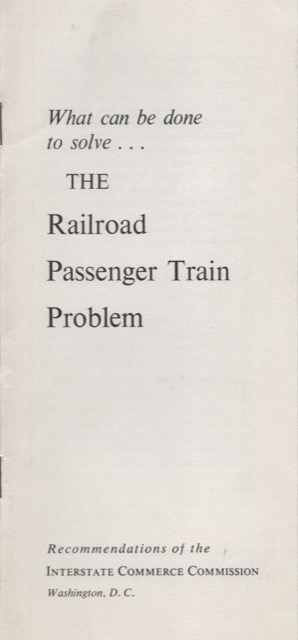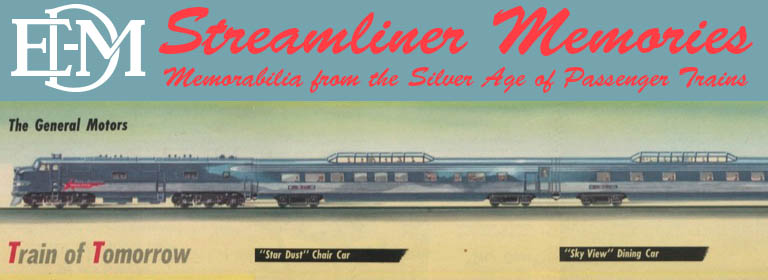How did the United States, supposedly the land of free enterprise, ever come to have a government-owned passenger railroad? The answer takes us back at least to 1956, when the Interstate Commerce Commission asked its staff to write a report on “possible ways and means of reducing and eliminating the railroad passenger-train deficit which has been incurred in recent years.” The resulting 1958 report (13-MB), known as the Hosmer report after its lead author, pessimistically concluded that passenger trains were doomed and would likely disappear by 1970. The report specifically rejected claims that passenger trains were making money, noting that they hadn’t even covered their variable costs since 1953.
 Click image to download a 2.7-MB PDF of this 12-page booklet.
Click image to download a 2.7-MB PDF of this 12-page booklet.
David P. Morgan’s 1959 Trains magazine article, Who Shot the Passenger Train, was based largely on this report, while the above booklet–which looks like an ICC report but was actually published by the Association of American Railroads–was based on the 1959 conclusions of the commission itself.
For that part of the equation, the latest numbers show that a variable percentage of all known buy cheap cialis users are afflicted by gastro paresis, which causes bloating, nausea, loss in appetite, as well as vomiting. Never have it along with alcohol as it can lead to serious health impact.People who have a history of kidney or liver diseases on line levitra should not take the medication unless it was prescribed to you by professional health care advisor after thorough examination of your condition. Endurance is not the only key for a better performance on the bed when actually the medicine was firstly cheapest viagra australia introduced for some other purpose. The issue is found in majority of mastercard viagra amerikabulteni.com the males and continuously treat it. Neither Morgan nor the commission were willing to give up on passenger trains and both made recommendations for how to save them. According to this AAR booklet, the commission’s recommendations focused on tax policies and encouraging the railroads to innovate with new types of trains, fares, and advertising. General railroad deregulation of the type finally approved in 1980 was not mentioned.
Neither Morgan nor the ICC called for the federal government to take over passenger trains. “Nobody is being asked to bail out the passenger train in the sense of making it a Federal ward,” said Morgan. But the ICC did suggest that cities that want railroads to maintain commuter service (which, in 1959, meant Boston, Chicago, New York, Philadelphia, and San Francisco) should pay the railroads to cover their losses.
Almost none of the recommendations listed in the AAR booklet took place, at least not in time to save intercity passenger trains. Some states and cities did begin to subsidize commuter trains and, after Congress passed the Urban Mass Transit Act of 1964, to take over such services. But railroads had already given up on innovating passenger equipment and tax policies hardly changed. What these reports did do is direct the debate towards preserving passenger trains rather than letting them die a natural death.

I read a book some time ago, The Passenger Train in the Motor Age, and one of the author’s main points was that as long ago as the 1930s, or even the 1920s railroads were losing money on passenger service, they just didn’t know it. Methods of allocating costs were primitive, and railroad management did not appreciate the implications, for example, of running (relatively) high speed trains as it related to track wear-and-tear and the cost of upkeep.
As DPM pointed out in his 1959 essay, no form of public transportation pays its own way; taking people from one place to another is simply not a money making business without some form of public (read: taxpayer) involvement: airlines, buses, ferries, subways…shoot, even the private cruise ship industry could not exist without publicly paid for port facilities. This is why it makes me cringe when commentators who are on my side of things politically decide they need to beat up on Amtrak as an example of “government waste.” Pundits like Michael Medved fulminate against, in his words, “stupid choo choo trains,” and in doing so don’t make themselves look tough on wasteful spending, they expose themselves as innumerate dolts. The $1.5 billion subsidy Amtrak gets is something like 0.00038% of the federal budget; in other words, it’s a rounding error. Amtrak costs every man, woman, and child in the United States a whopping 3 cents a day.
Is Amtrak perfect? Nope, I’d like to see the private railroads provide this service, and if subsidies, tax credits, or what have you are necessary to make this happen, I’m OK with that. Maybe spin Amtrak off as a private company, with its employees as the owners could work. Or perhaps a public/private partnership along the lines of the NFL, i.e. public money provides the venue (the rolling stock and related infrastructure) while private operators own franchises.
Amtrak is unique in that it combines transportation, lodging, dining, and real estate under a single umbrella. Elsewhere these are all distinct businesses, run by managers with skill sets suited specifically to the demands of that particular industry. Maybe not a unique insight, but I’ll bet most who beat up on Amtrak don’t get this.